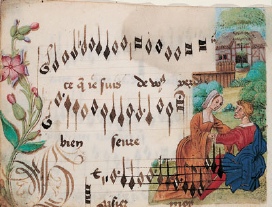 |
| The University of Miami Library hosted several large cases of its facsimiles for the 2010 Fall Term. Musicologist Frank Cooper writes about them. see exhibit: Music for the Eyes Reprinted with permission from the author |
That observation by a teacher I had in the tenth grade has ever charged my curiosity Ė to the occasional puzzlement of others. With knowledge having no limits for me or anyone else beyond what is imposed upon it by our gifts, the world lies before us arrayed in portions some of which can be held in the hands. Musical scores are good examples. A scoreís graphic layout symbolizes its composerís complex idea for an esthetic experience of audible time. Musicians spend their lives divining interpretations from editions prepared by experts. Usually two types of edition prevail in common experience: the practical, which proposes solutions to problems of performance; and the urtext, which purports to convey only what the composer wrote. Both have been readily available in print for the past century and a half and now can be accessed via the Internet in electronic form. Each one of these places another degree of separation between the author and the musician. There is, however, another - the primary source called the holograph, and that provides closeness. Deriving from the Latin holographus, it means the manuscript entirely written by hand. It is the unique record of the composerís activity unalloyed by any other means. It is therefore rare, precious and subject to the vagaries of human contact and storage conditions - thus to be protected, secreted, guarded and unavailable to the curious. Libraries in Spain, Italy, Germany, England, France, Russia and the United States preserve manuscript treasures which span centuries and sometimes are displayed in locked glass cases. Books of history often reproduce isolated pages from such works to give the reader an idea of the originalís appearance. The size of those images is determined not by the originalís page size but by that of the publication and are often even smaller, rather like postage stamps. The sense of contact with the source remains undeveloped, hence the mind remains unexcited. Facsimiles bridge that gap, for they can be used by individuals and in classes to spur both imagination and understanding. At a glance can be seen the left-handed Beethovenís ink being smeared by his sleeve, the emotions of Puccini as he enlarges or diminishes his script to enliven the visual aspect of changes in dynamics and tempo, the steady hand of a medieval scribe rendering on a four-line staff the collective voice of awed mankindís songs to God, the exquisite finesse of a Renaissance painter decorating the lyrics and tunes of earthly love. Facsimiles allow an experience which is immediately stimulating. You can touch them, riffle their pages, stop where you wish to savor a point of interest, feel their weight, imagine what they must have meant before anyone ever rendered the originals into print. Through our collection of facsimiles music history is brought to life for our faculty and for our students. When not shown in cases such as these, every facsimile that we own is available for personal inspection and study by anyone with a Cane Card. Thus do we open the doors for hands-on contact with the evidence of history.
FRANK COOPER